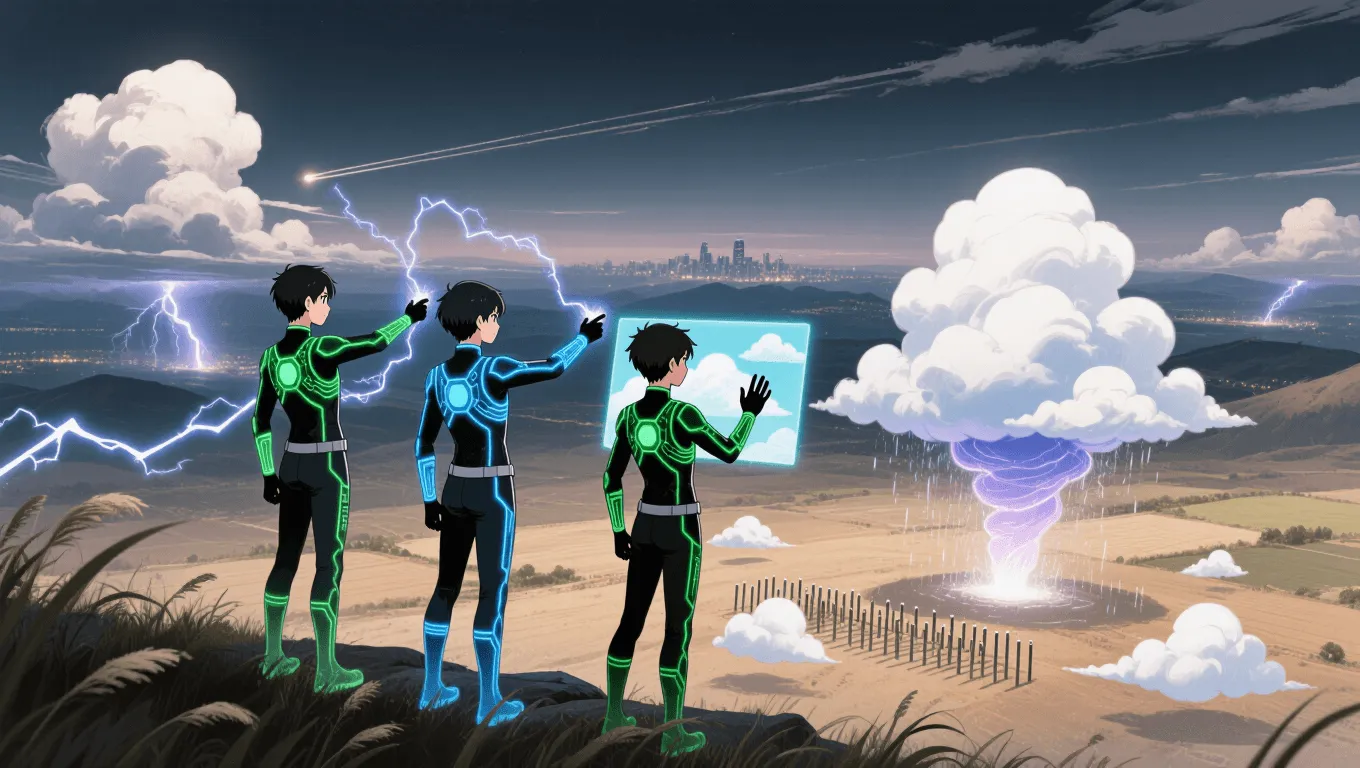Bio-Weather Control: Complete Guide

Bio-Weather Control Video Demo 🎬
Table of Contents
- Bio-Weather Control Video Demo 🎬
- What Is Bio-Weather Control
- Core Abilities of Bio-Weather Control
- Application / Tactical Advantages in Combat
- Level: Level 1 🏙️, Level 2 🌇, Level 3 🌃
- Limitations of Using the Bio-Weather Control
- Weakness Against What Other Superpowers
- Synergistic Power Combos
- Known Users
Bio-Weather Control is the rare ability to influence weather patterns through living biology—using one’s own body, nearby organisms, or a biofield to steer wind, rain, temperature, and even lightning. Unlike standard weather manipulation, this form blends biokinesis with meteorological control, creating a living feedback loop between cells and climate. It’s part ecosystem empathy, part storm generation, and part climate manipulation. Explore more powers like this in our Superpower Wiki or discover a new idea with the random superpower generator.
What Is Bio-Weather Control
Bio-Weather Control allows a user to regulate atmospheric conditions by tapping into biological processes. Instead of “willing” a storm from thin air, the user amplifies natural signals—heat released by muscles, moisture from transpiration, electrochemical gradients across cell membranes—and scales them into meteorological effects. The result is an organic interface with the sky: heart rate aligns with barometric pressure, breathing paces wind currents, and plant life becomes a network of humidity generators and air ionizers.
In practical terms, the power blends elements of biokinesis, aerokinesis, hydrokinesis, thermokinesis, and electrokinesis, but routes these through living systems. The user becomes a mobile weather node, able to seed clouds, redirect stormfronts, or stabilize microclimates that shelter allies.
Core Abilities of Bio-Weather Control
Cell-to-Climate Interface
The cornerstone of Bio-Weather Control is a two-way link between biological rhythms and atmospheric variables. By modulating pulse, body temperature, and neuromuscular microcurrents, the user nudges wind shear, humidity, and pressure gradients. Think of it as a biofeedback loop that scales from cellular sparks to sky-wide currents.
Humidity & Precipitation Shaping
Through enhanced perspiration control, pulmonary moisture exchange, and botanical transpiration via symbiotic flora, the user can raise or lower local humidity. At higher mastery, they can form cloud banks, trigger drizzle for visibility denial, or wring moisture from saturated air to refill reservoirs—useful for drought relief or battlefield obscuration.
Thermal Regulation & Microclimates
Adjusting metabolic heat and leveraging surrounding biomass, the user crafts temperature pockets: cool bubbles to counter heat waves, or warm corridors to prevent hypothermia. These microclimates can protect squads, stabilize refugee zones, or create thermal updrafts for aerial allies.
Wind & Pressure Modulation
By synchronizing breath patterns and vascular rhythms with ambient pressure, the user can shape localized breezes, steer smoke, and influence barometric dips that “invite” storms. At advanced tiers, subtle pressure banks can stall projectiles or carry aerosolized agents away from civilians.
Electrobiological Stormcasting
Bioelectric fields scale into electrostatic discharge. With precise ion manipulation, the user can charge cloud layers for lightning calls, or bleed charge to neutralize dangerous buildup. This ability doubles as an EMP-lite for delicate electronics—though Bio-Weather Control emphasizes natural ion flow, not brute-force electromagnetic pulses.
Flora–Fauna Mediation
Ecosystem empathy lets the user enlist plants (for humidity and air chemistry) and animals (for behavioral cues preceding storms). With a botanical interface, they can accelerate photosynthetic cooling, trigger mass stomatal opening for rapid cloud seeding, or calm fauna whose flight responses presage severe weather.
Sensory & Diagnostics (Biometeorology Sense)
Beyond making weather, the user “reads” it. They feel pressure troughs as headaches, taste metallic charge before lightning, and detect invisible fronts as changes in skin conductance. This predictive sense turns the user into a walking early-warning system.
Application / Tactical Advantages in Combat
Battlefield Control
Fog curtains obscure enemy optics, wind corridors redirect gas plumes, and sudden downpours loosen footing. Thermal pockets can neutralize heat-seeking ordnance. A seasoned user can re-sculpt engagement ranges by compressing or expanding visibility and mobility lanes.
Force Protection
Microclimate domes keep dust, embers, and shrapnel-sparked fires away from civilians or medics. Controlled rainfall dampens explosive risks and cools overheated gear. Clean-air channels reduce smoke inhalation during urban fires.
Non-Lethal Deterrence
Barometric headaches, ion balance tweaks, and wind-blown irritants can disperse hostile crowds with minimal harm. Gentle rain and lowered temperatures reduce aggression and fatigue opponents without lasting damage.
Mobility & Extraction
Tailwinds speed evac choppers or gliders; tail-currents clear landing zones. On water, pressure steering flattens choppy waves for safer extraction. In snowy terrain, localized thaws or packed-snow winds create stable routes.
Counter-Tech Interference
Electrostatic tuning can degrade drone propellers’ efficiency, push micro-UAVs off course, or garble light airborne sensors. Moisture bursts short out exposed circuits and reduce thermal signatures that targeting systems track.
Humanitarian & Aftermath Roles
Post-battle, the same toolkit prevents disease by controlling stagnant heat and humidity, accelerates smoke clearing, and summons gentle rains to settle dust—mitigating civilian harm and ecological damage.
Level: Level 1 🏙️, Level 2 🌇, Level 3 🌃
Level 1 🏙️ — Localized Bio-Weather Nudge
Beginners sense incoming weather and make subtle tweaks: a breeze through an alley, a light mist over a garden, or a degree or two of temperature moderation. Effects are neighborhood-scale at most and short-lived. The user relies heavily on proximity to vegetation and clean air.

Signature moves:
-
Street-level wind steering to disrupt drones or smoke
-
Cooling canopies for small teams
-
Drizzle veils for quick cover
Training focus: Breathwork, hydration control, and linking heartbeat with wind tempo.
Level 2 🌇 — Urban Microclimate Architect
Intermediate users establish persistent microclimates over city blocks, balancing humidity and heat, stabilizing air quality, and maintaining reliable fog banks or clear corridors. They begin to tap stormfront shaping and targeted rainfall without flash flooding.

Signature moves:
-
Heat dome punctures to end heat fatigue
-
Fog walls that defeat thermal and optical targeting
-
Rain-on, rain-off precision for fire control
Training focus: Plant–air chemistry, pressure mapping, and sustained metabolic pacing.
Level 3 🌃 — Biotic Stormwright
Masters act on mesoscale systems: inviting a thunderhead to linger, deflecting a squall line, or bleeding charge to prevent catastrophic lightning strikes. They coordinate with ecosystems to produce rain cycles, influence jet-level shear locally, and stabilize entire regions during crises.

Signature moves:
-
Lightning shepherding with safe groundouts
-
Stormfront redirection to unpopulated corridors
-
Region-wide heatwave relief via staged cloud seeding
Training focus: Long-duration biofeedback, high-load electrolyte management, and ecosystem orchestration.
Limitations of Using the Bio-Weather Control
Physiological Strain: Scaling biology to sky processes taxes electrolytes, glucose, and autonomic control. Overuse leads to arrhythmias, dehydration, hypoglycemia, or immune dips. Recovery windows are essential.
Ecosystem Dependency: The power thrives where there’s biomass and moisture to leverage. Desert interiors, sealed sterile facilities, or high-altitude voids reduce efficacy unless the user preps reservoirs or carries living mediums (seed pods, microalgae packs).
Range vs. Precision Trade-off: Wide-area influence blurs fine control. Tight effects (like a surgical gust to deflect a projectile) demand focus that limits broader weather shaping.
Urban Interference: Concrete heat islands, pollution, and chaotic airflow complicate clean outcomes. Users must first “fix the air”—ventilating particulates or cooling reflective surfaces—before shaping storms.
Ethical and Environmental Constraints: Forcing rain from one area may starve another watershed. Responsible users model downstream effects and avoid long-term distortions in local climate.
Signal Noise from Tech: Strong EM fields or acoustic infrasound can disrupt the biofeedback link. Industrial plants, rail hubs, or sonic weapons add “noise” that complicates control.
Weakness Against What Other Superpowers
Power Nullification: Any ability that suppresses metahuman effects can sever the bio–atmosphere link, collapsing active storms or microclimates.
Vacuum/Atmospheric Removal: Aerovacuums or space-time rifts that vent air eliminate the medium Bio-Weather Control manipulates.
Gravitokinesis: Gravity shapers can override convection, squash updrafts, and pin storm cells, neutralizing cloud growth and lightning pathways.
Pyrokinesis (High-Temp Spikes): Rapid, localized heat can break cloud cohesion and dry out humidity banks before rain forms. Extreme thermal bursts undo carefully tuned microclimates.
Toxin/Bio-Disruption: Hemotoxic or neuroactive powers attack the user’s physiology—scrambling heart–breath coherence and blocking the cell-to-climate interface.
Technopathy with EM Mastery: While the power is biological, technopaths controlling broadcast arrays or ionizers can flood the environment with counter-signals to jam fine control.
Sound/Resonance Manipulation: Infrasound that targets vagal tone or vestibular stability shakes the user’s autonomic rhythms, degrading precision.
Synergistic Power Combos
Hydrokinesis + Bio-Weather Control: A water-shaper captures and channels the rain the bio-weather user summons, turning downpour into tactical reservoirs, pressure washers, or protective curtains.
Aerokinesis + Bio-Weather Control: Dedicated wind control pairs with biological sensing to sculpt laminar corridors for aircraft, boost glider troops, and whip up storm bands without stalling.
Electrokinesis + Bio-Weather Control: A lightning specialist “reads” charge the bio-weather user accumulates, then discharges it safely or offensively with pinpoint arcs.
Plant Manipulation + Bio-Weather Control: Botanical allies increase transpiration, ionize air with volatile organics, and provide living lattices for humidity capture—supercharging cloud seeding and air scrubbing.
Geomancy + Bio-Weather Control: Ground shapers raise windbreaks, water catchments, and reflective surfaces, providing terrain that amplifies and sustains microclimates.
Cryokinesis + Bio-Weather Control: Ice and snow shaping turn cooled air pockets into sleet bursts, hail denial, or avalanche control—key in alpine theaters.
Healing/Biokinesis + Bio-Weather Control: Healers maintain the user’s electrolyte balance and cardiac rhythm during long operations, extending safe operating windows.
Known Users
While “Bio-Weather Control” is a specialized term, several fictional characters demonstrate closely related abilities:
-
Storm (Ororo Munroe) — A premier weather manipulator whose empathic bond with the atmosphere often reads like a living dialogue with the sky.
-
Swamp Thing — As avatar of the Green, he leverages plant networks and ecosystem ties, occasionally influencing local weather through biotic systems.
-
Poison Ivy — Botanical control and plant–air chemistry mastery that can alter humidity and air composition, laying groundwork for microclimate shifts.
For more related powers and deeper dives, browse the evolving entries in our Superpower Wiki or spark inspiration with the random superpower generator.
